
Taking the long way round, Monica Meade takes Costa Rica’s rapidly developing—though sometimes unpredictable—nationwide EV charging infrastructure for a spin.

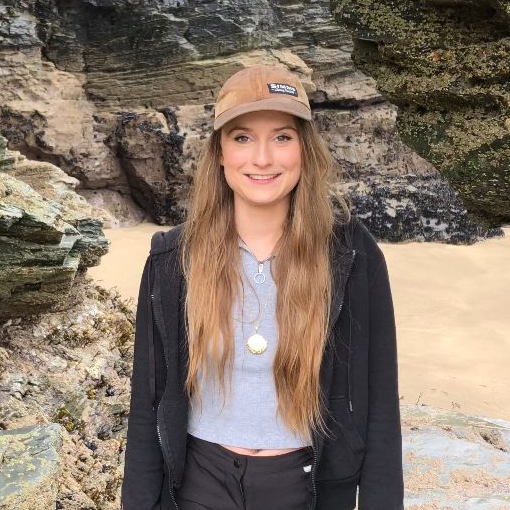
Taking the long way round, Monica Meade takes Costa Rica’s rapidly developing—though sometimes unpredictable—nationwide EV charging infrastructure for a spin.
Keen to avoid tripping onto the dinner table of a hungry predator, I flick on my flashlight to navigate between suspiciously breathing shrubs. It’s night two of my 900-mile EV girls’ road trip in Costa Rica after a dreamy day in the sloth-filled reserves and empty beaches of the remote, eastern Caribbean Coast. But we’re about to break one of our first rules: Don’t drive in the dark—the roads are bendy, unlit, and without reflectors.
Before we can even begin searching for our camouflaged, jungle-wrapped car, ahead of us is a 30-minute walk through the pitch-black Manzanillo Gandoca Wildlife Reserve. It starts as a leisurely stroll as we’re mesmerized by a 360º of fireflies before a chain of uncanny bellows from the depths of hell inspires an evening sprint. Miraculously, we’re belted up with the engine on within 15 minutes—none of us had heard the territorial calls of the loudest land mammals on Earth before—the adorable, silky black howler monkey.
Chaos has commenced, and me and my road trip friends Hannah, Lydia, and Nancy are in it for the ride. Within the first few hours of arriving in San José yesterday, I’d already driven the wrong way on a one-way street and at our first roadside view stop, we pulled over next to an abnormally large snake.
But the mishaps only fuel our hysteria—we’ve been quick to catch the contagious ‘life is good’, ‘Pura Vida’ attitude. Maybe it’s needed for our high-mileage feat, deemed “crazy” by the rental company as they handed over the keys to our EV.
Over the next two weeks, we plan on driving almost an entire loop of Costa Rica. Today, we’re near the northwest Panama border in Manzanillo, having completed our first 150 miles from San José.
From here, we’ll travel north along the Caribbean Coast for the water mazes of Tortuguero, which is only accessible by boat. Then we’ll cut west across the volcanic northern lowlands and circuit the 32-square-mile Lake Arenal before navigating south through dense, mountainous rainforests. After descending to sea level, we’ll follow the Pacific Coast to the southern village of Uvita before returning to San José.
“I’ll always use an electric engine, it’s much better for the environment. The boats with petrol engines are noisy and fast. The sound scares the animals deeper into the trees and their waves erode the river banks—the river is getting wider and shallower.”
- Castor Hunter Thomas, guide
“Most people just do the one coast,” Eric Orlich says. Orlich is the director of Green Circle Experience (where we hired the car) and president of Asomove, a Costa Rican non-profit NGO that promotes electric mobility. Orlich tells us about the 300 percent increase in EVs on the road here from 2022 to 2023 and the developing infrastructure across the country—with 267 public chargers to date.
On paper, the 900-mile route should now be possible in an EV. But we’re warned about the temperamental roadside plug-in points, sporadic regional electricity blackouts, and long distances without charging stations.
Cruising in style, we’re in a seven-seater SUV called the Youcan—inspired by the founder’s son Youp who loves toucans and has cerebral palsy. It’s one of many EVs owned by locals and hired out by this eco-tourism travel agency, who donate 10 percent of the rental fees to local charities—we’ll be supporting Dynamika, a cerebral palsy therapy, play, and education organization.
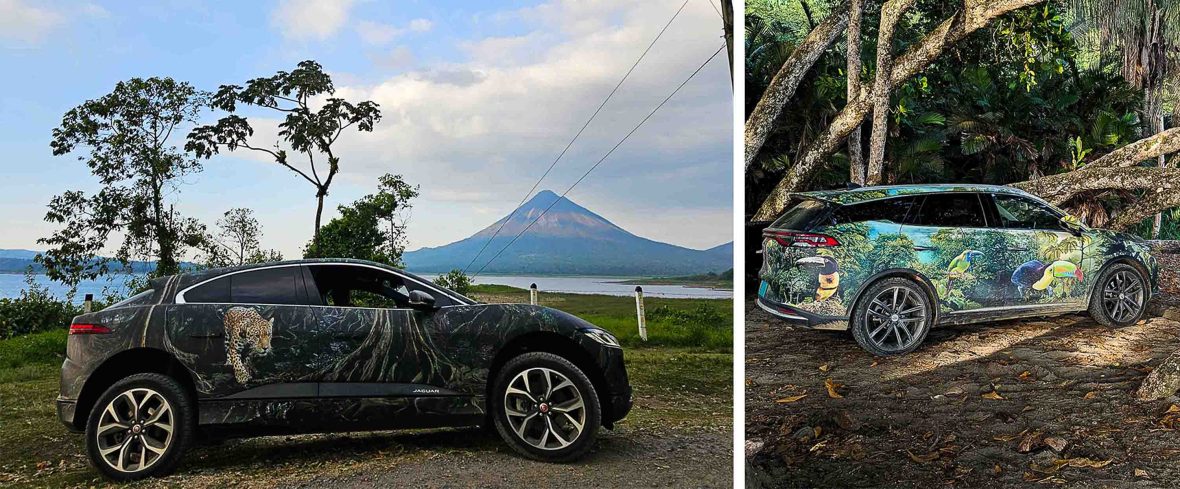
On our last evening on the sleepy southern coast we go for dinner in Puerto Viejo de Talamanca, a village slightly east of Manzanillo. Tucking into slow-cooked, spiced coconut curries as Calypso classics fill the Jamaican-owned Tamara restaurant. Beginning life as a family ‘soda’ [family-run café] selling confectionery, natural juices, and candies where young locals would gather to discuss life, eat, and play dominos, it also serves as a reminder of the legacy of the hundreds of Jamaican rail workers who arrived on the Caribbean coast in the late 19th century.
Snack stops and subpar Spanish singing to our Costa Rica-inspired playlist keep us blissfully distracted from the dwindling EV battery as we cruise north. Four hours later, we’re at La Pavona Docks, 18 miles below southeast Nicaragua. Backpacks on, we leave the car for a passenger boat into the turtle-haven and eco-tourism hub Tortuguero National Park.
We’re based in the car-free village of Tortuguero for a couple of days, located on a sandbar island among 77,000 acres of protected canals, lagoons, and swamps. As well as learning how to back away from a jaguar, should one appear during our hike, visiting the Turtle Conservation Center, and not being eaten by the crocodile that popped up five feet away from our canoe during a tour with legendary local Castor Hunter Thomas, we discover some realities of tourism here.
“I’ll always use an electric engine, it’s much better for the environment,” Castor says. “The boats with petrol engines are noisy and fast. The sound scares the animals deeper into the trees and their waves erode the river banks—the river is getting wider and shallower.” Shortly after we leave Tortuguero, we realize his words had been a prequel to our journey to La Pavona.
On the boat, we repeatedly get stuck on the riverbed until the engine eventually gives up. A group of Spanish lads on board jump out and push us the final few miles through murky waist-deep water while the rest of us watch for crocodiles. Next time, we’ll opt for a smaller boat along the slower and less disturbed route Castor mentioned from Moin Docks, further south.
Back on the road, we’re eastbound to La Fortuna town, at the base of the cone-shaped Arenal Volcano. There’s silence in the car as we rapidly approach the six-mile battery reserves, but thankfully we’re saved by Electromaps, the nifty local EV public charging point locator app.
The next few days are a discovery of the unique ecosystems and landscapes formed by Arenal stratovolcano, one of the most active in the world. We chill out in magma-heated, natural mineral pools of Tabacón hot springs and explore the lava flows from Arenal’s 1968 eruption on foot. At sunset, we take kayaks onto Lake Arenal for silhouette views of the restless volcano.
West of the lake is Costa Rica’s turquoise jewel, Rio Celeste. We wander along its bubbling, milky blue river and mystical waterfalls which according to myth were tinted by the gods after dipping their paint brushes in the water while painting the sky. Tubing further along the river, we race each other down the whirling rapids.
“Living under the principles and ethics of permaculture, you will have an extraordinary life. It means care for the Earth, care for people, and fair share—apply this to everything.”
- Alfredo Echeverria, Valle Escondido Nature Reserve Hotel & Farm
It’s a steep and twisting, low-gear climb along sheer-edged mountain roads into the cloud forests. To break up the tense drive, we stop at viewpoints along the way and an unassuming shack—Chorotega Arts & Crafts.
The owner and artist Marcelo Oliveira is one of few Indian craftsmen in Costa Rica. He dedicates his life to preserving the 3,000-year-old craft of the Indigenous Chorotega peoples, one of the most powerful American Indian tribes of northwest Costa Rica during the Spanish conquest.
“Everything is 100 percent natural and made by hand, using materials from the local farms, mountains, and volcano,” Marcelo says. A pottery fiend herself, Nancy is fascinated by the hand-spun wheel and traditional, natural instruments for shaping and polishing each piece, which can take around 50 hours to perfect.
It’s only about 30 minutes to the green northern mountains of Monteverde, south of La Fortuna. Working with the land’s plentiful natural resources is a common theme, and we’re reminded again at the 300-hectare Valle Escondido Nature Reserve Hotel & Farm. “Living under the principles and ethics of permaculture, you will have an extraordinary life,” general manager Alfredo Echeverria says. “It means care for the Earth, care for people, and fair share—apply this to everything.”
With infectious, wholesome positivity, he offers his most valuable knowledge, like how the water systems include natural filtering through the earth using gravity. He also shares the recipe for their fine-tuned organic soil to grow vegetables without land degradation—like discarded eggshells for calcium and kitchen chimenea ash for potassium. Everything here is recycled and reused, serving to enrich other parts of the permaculture system.
We keep Alfredo’s words in mind when choosing lesser-known alternatives to over-visited Monteverde Cloud Forest Reserve and the busy canopy bridges. El Tigre Waterfalls Reserve is filled with semi-wild walkways winding through the thick rainforest. The place is pretty much empty. It’s just us and the morpho butterflies as we follow a network of wobbly rope bridges and jump into pooling 100-foot cascades.
It’s drizzly when we arrive at Monteverde’s Santa Elena Cloud Forest Reserve but like the receptionist says, this is when the plants come to life. At the start of the 1.6-mile Yellow Trail, a sign introduces us to the Japanese forest bathing practice Shinrin-Yoku. Using the prompts, I breathe deeply, alternating my focus on each of my senses. We all begin noticing more around us and our zen turns into bursts of excitement as Hannah drags me over to a “particularly peppery”-smelling leaf she’s sniffed out, and Lydia makes us freeze until we tune into her new favorite birdsong.
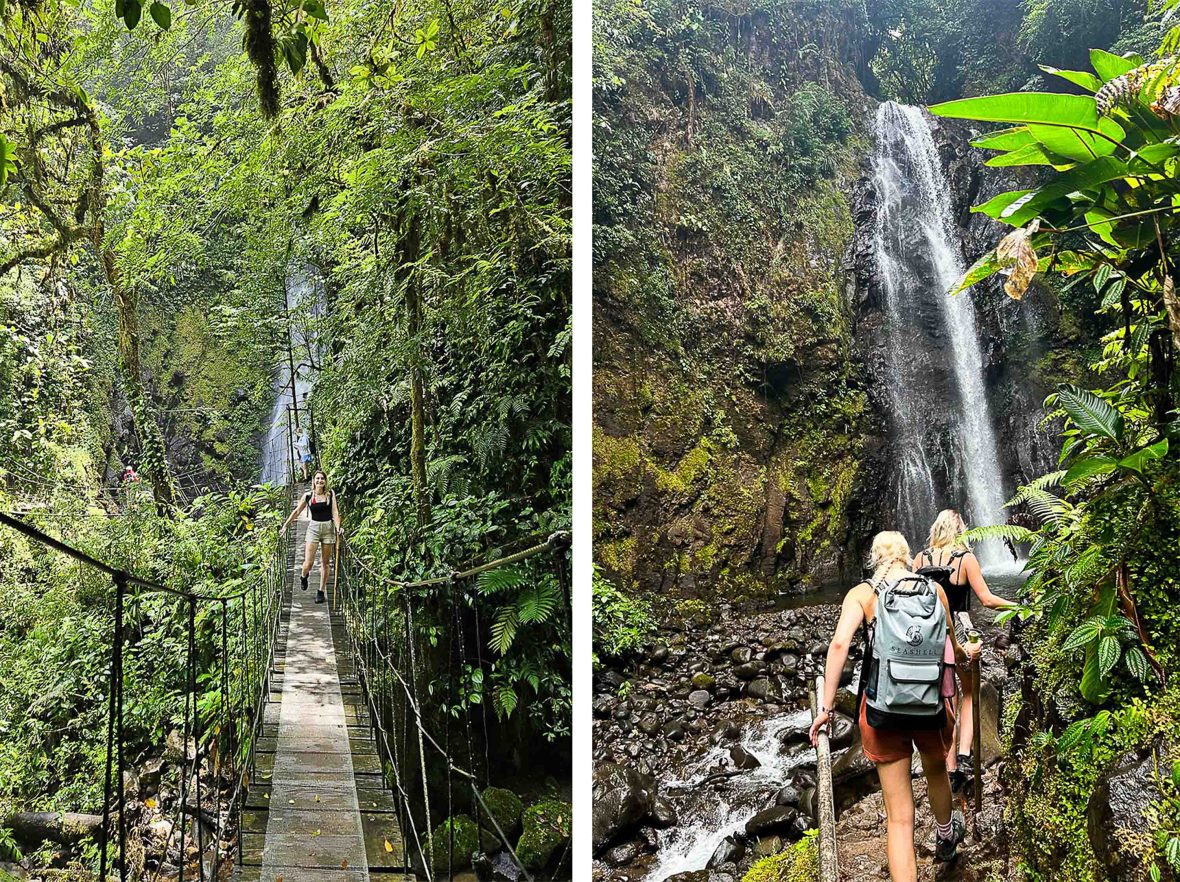
It’s a 156-mile drive to the South Pacific, slicing through miles of palm tree plantations before a short detour into the hills of Ballena, between the southeastern mountains and coastline. Outside of a thatched wooden hut smoke pluming through its open sides is Ronald Alpízar, the owner of Pre-Columbian Chocolate Tours.
Ronald shows us the product of his childhood dream, a cacao plantation where he lives in harmony with nature. “I built this bridge for the monkeys—around 80 percent of my cacao is eaten by them and the squirrels, but I don’t care—they’ve been eating them for thousands of years,” he says.
“We had enough of the rubbish and turtles tied up in plastic,” Angela tells me. In 2002, she and her friends began clearing 70 kilos of washed-up trash twice a month. Now there’s only 12 kilos each time.
“People forget what real chocolate is—it was good for you until the world discovered candy bars in 1847,” says Ronald. We heat a batch of beans to peel and grind them using an ancient Pre-Columbian metate bowl, eventually transforming them into steaming hot chocolate. “It was a drink of the Gods,” Ronald says as he pours the drink from a height into four mugs, releasing aromas just like the Mayans would do during rituals and sacrifices.
Ten minutes down the road is the small southern village of Uvita, on the shores of the country’s watersports wonderland. We’re late to our first-ever surfing lesson, at the nearby Playa Hermosa beach, and the waves are getting tall and feisty. Somehow I’m standing up on the first attempt and Lydia follows suit with her second wave. Despite a battering, all four of us spend two hours successfully surfing. Maybe there was some magic in those hot chocolates after all.
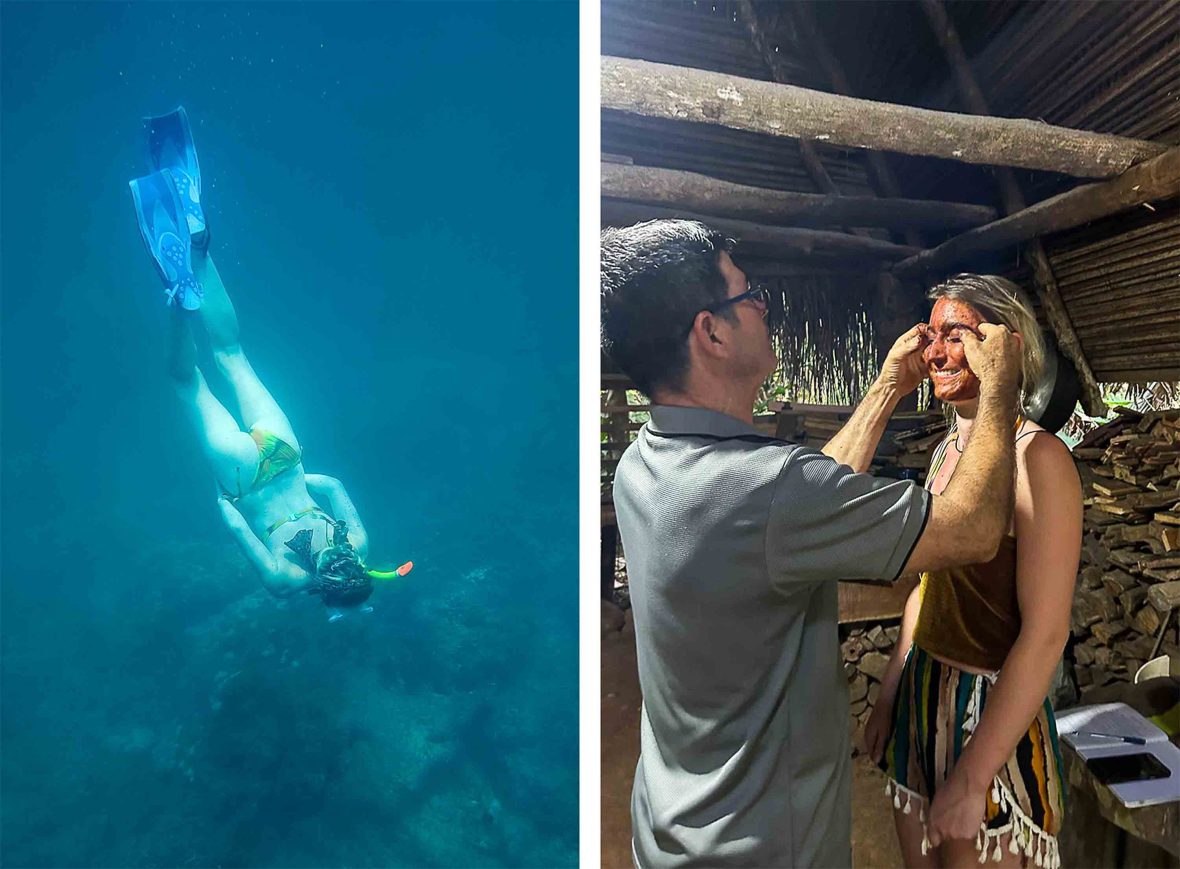
On the morning of our last full day, we’re 10 miles off the mainland, snorkeling and freediving the waters around Cano Island. “It’s the second-best reef in Costa Rica,” Mariela Olmos, a passionate freediver and Ballena Tour guide says. Dipping beneath the surface, we swim amongst stingrays, a Hawksbill turtle, and slender, white-tipped reef sharks.
Chatting to Mariela about the chalky white coral says she’s watched it fade over a decade. But she and her friends do what they can to protect it, as I discover when she takes us to Playa Hermosa beach.
Pulsing house music leads us to a crowd surrounding DJ decks on the sand and in the middle is Angela Delgado, the founder of ocean conservation charity AmbiciOsas. “We’re here to make noise,” she says. Every other week they gather a crowd with megaphones, a resident DJ, and social media posts for a beach clean-up party.
“We had enough of the rubbish and turtles tied up in plastic,” Angela tells me. In 2002, she and her friends began clearing 70 kilos of washed-up trash twice a month. Now there’s only 12 kilos each time. Since then, AmbiciOsas has opened the first research and recycling center in Costa Rica’s South Pacific, and started running ocean conservation workshops for businesses and kids.
It’s our final morning, and instead of preparing for our 132-mile drive to the capital’s airport, we take it easy. It’s the perfect time to get a ‘pura vida’ tattoo on my arm, a permanent reminder to take things as they come and lean into the good life. It proves helpful when we realize there’s not enough car battery to get us to the airport. But we make it there, in the end, an hour before departure.
**
The writer was hosted on a personalized, 14-day self-drive Costa Rica tour with Green Circle Experience which includes an electric rental car, eco-lodge stays, and free EV charging at partnered hotels.
****
Adventure.com strives to be a low-emissions travel publication. We are powered by, but editorially independent of, Intrepid Travel, the world’s largest travel B Corp, who help ensure Adventure.com maintains high standards of sustainability in our work and activities. You can visit our sustainability page or read our Contributor Impact Guidelines for more information.

Monica is a travel writer who advocates slow and immersive travel, particularly in secluded and untouched locations. She has a soft spot for tiny islands, is always up for an adrenaline sport and has a talent for returning from hikes covered in mud and scratches. Her bylines appear in publications such as British Airways The Club, Life Lovers Magazine and IAG Cargo magazine.


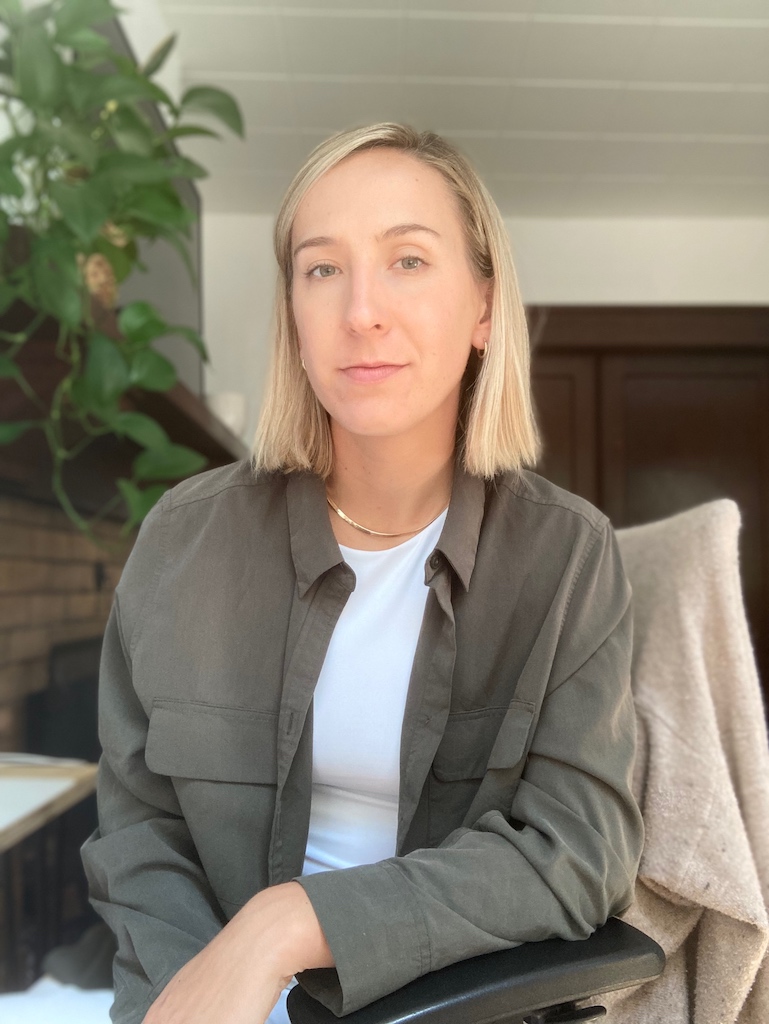





Can't find what you're looking for? Try using these tags: